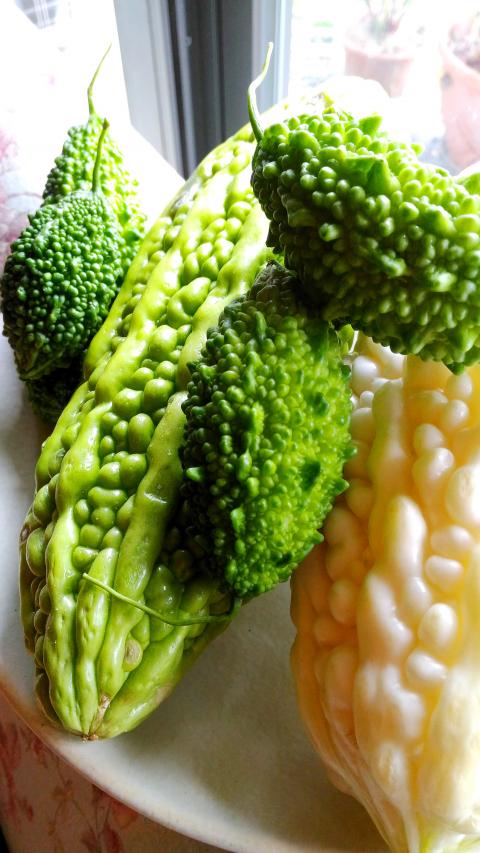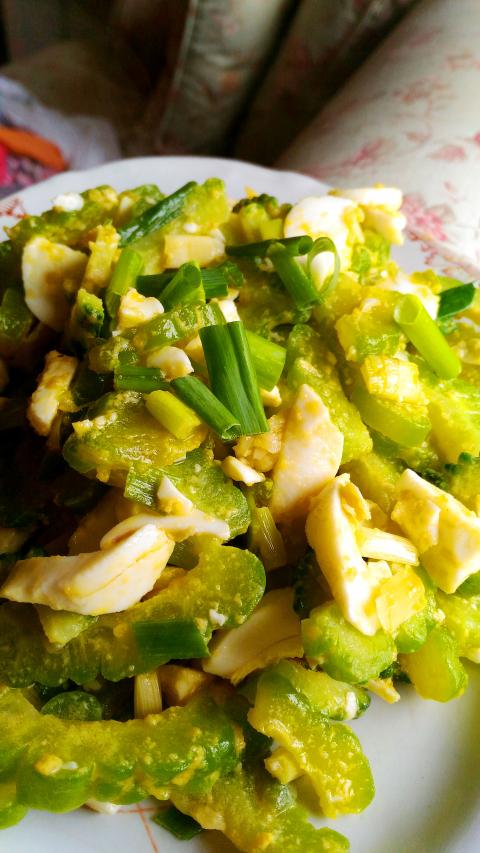Bitter melon (苦瓜) is not an appealing marketing prospect, one of the reasons that this amazing vegetable is so greatly undervalued. The first hurdle is in its name. How is this appealing? Gourds, and bitter gourd is another name for this vegetable, have a hard enough time as it is, but add the word bitter in front of it, and even gourd-lovers turn sheepish. Not that this excellent vegetable — technically a fruit — doesn’t have its supporters, and bitterness is certainly making gains in the modern, experimental culinary world.
In 2014, the Australian chef Jennifer McLagan published the cookbook Bitter: A Taste of the World’s Most Dangerous Flavor, part of a push by culinary enthusiasts to bring people back to an appreciation of a much maligned flavor. Arugula, frisee and mesclun are now part of any good salad selection. Outside the world of vegetables, this shift has been echoed by a punchy reinvention of the traditional IPA beer style, with its heavy use of hops and an aggressive assertion of the appeal of bitterness. The fact that even profound bitterness really has special appeal is suggested by the emergence of double and even triple IPAs that take the idea of bitter beer to whole new levels of mouth-puckering excellence.
The degree of bitterness offered by bitter melon is suggested by the fact that even in a book dedicated to the flavor of bitterness, McLagan says that “bitter melon, … is probably the bitterest vegetable that you will encounter.” And this among numerous recipes featuring rabini, chicory, rutabagas, endive and cardoon!

Photo: Ian Bartholomew
This seems a little harsh, but totally understandable given the negative associations that even the word “bitter” has in both Chinese and English-speaking cultures. Bitterness is a bad thing — and science even tells us that our dislike of bitter flavor is part of an evolutionary instinct that warns us away from foods that may be harmful, such as toxic plants. But it would seem that our fear of bitterness has become almost hysterical, and the agricultural and culinary world try to breed out bitterness in all kinds of food, from eggplants to cucumbers, with the hope of broadening their appeal.
This is sad, for bitterness, despite evolving into a signpost for toxic foods, are also associated with foods that are important in stimulating our immune system and providing a wide range of health benefits.
In Chinese medicine, bitter flavors are associated with detoxification of the system and as necessary to bring the body back into balance after over-indulgence in rich food. Ayurvedic medicine also associates bitterness with cleansing of the blood and promotion of stomach and liver function. Most significant from a health perspective is the presence of charantin, which has been confirmed to have a blood glucose-lowering effect, vicine and an insulin-like compound known as polypeptide-p, all of which show powerful effects in the treatment of diabetes.

Photo: Ian Bartholomew
CHOOSING THE RIGHT BITTER MELON
While the flavor of bitter melon can be off putting, a little care in preparation can mitigate its most aggressive aspects while retaining its complex flavor. The first thing to bear in mind is the selection of the bitter melon, which is widely available in three types, each with quite distinctive characteristics. One of the most popular is the white jade bitter melon (白玉苦瓜), which has a mild flavor and a soft flesh, and is favored for the classic dish Spare ribs with Bitter Melon (苦瓜排骨湯). There is also a large green melon (綠苦瓜), which has a more assertive flavor and crisper texture. Then there is the mountain bitter melon (山苦瓜), which compensates for its small size with a much more aggressive flavor. It has the deepest and most complex flavor and is particularly good served as a cold dish, lightly tossed in soy, vinegar and chili oil.
Many recipes recommend removing the seeds and pulp of the bitter melon, as these are the bitterest part. This is required for some bigger melons, but for the mountain bitter melon, with its tiny seeds, this is optional. The seeds provide a lovely additional crunch, but this comes with an added hit of bitterness.
To give bitter melon wider appeal, slices can then be blanched for 30 seconds or a minute in boiling water, or salted for an hour then washed. Both these processes make the melon more mild and accessible. It can also be paired with a coconut curry, as is found in Indian or Thai cuisine, or cooked with highly flavored oil, as in the Taiwanese standard of Bitter Melon Stewed in Oil (油悶苦瓜), but such palaver is hardly necessary, and bitter melon generally shines best in the simplest preparations.
Bitter Melon with Salted Duck Egg
Recipe
(serves four)
This dish is a staple of Taiwanese cuisine and one of the nicest ways to eat bitter melon. It is also one of the simplest to put together. It is best made with a large green bitter melon, but for those who rejoice in bitterness, wild or mountain bitter melon builds a dish that has greater depth. Despite its simplicity, this dish is perfect with a bowl of rice, but add a highly flavored meat dish, and it really shines as an accompaniment. Be aware that the bitterness can vary significantly between different types of bitter melon, with white or jade melons the mildest and the smallest greenest ones often sharply bitter (and preferred by aficionados for just that reason).
Ingredients
1 medium sized green bitter melon
2 cooked salted duck eggs
2 stems spring onions, roughly chopped
1 clove garlic, minced
Salt and white pepper
1/2 cup vegetable stock (optional)
2 tbsp vegetable oil
Directions
1. Cut the bitter melon length-wise and dig out the seeds with a spoon. (With smaller melons, this may not be necessary, especially if you enjoy the bitter flavor of these vegetables, but if you are not sure, then its best to dig them out until you subsequently realize what you are missing.)
2. Slice the bitter melon into thin slices.
3. Bring a pot of water to a boil. Blanch the sliced bitter melon for about 1 minute then drain and set aside.
4. Prepare the salted duck eggs by peeling them and separating yolk and white. (Cooked duck eggs can be difficult to peel and the quickest method is to cut the eggs in half with a sharp knife then scoop out the half egg with a spoon.)
5. Heat a pan with oil and add the yolk of the duck egg, breaking it up with the spatula. When the yolk starts to foam, throw in the garlic and spring onions and cook for a further 30 seconds before adding the blanched bitter melon slices. Mix well.
6. If the mixture is too dry, add a little stock or water to loosen it up. Season with salt and white pepper.
7. Serve with rice.
Ian Bartholomew runs Ian’s Table, a small guesthouse in Hualien. He has lived in Taiwan for many years writing about the food scene and has decided that until you look at farming, you know nothing about the food you eat. He can be contacted at Hualien202@gmail.com.

In the next few months tough decisions will need to be made by the Taiwan People’s Party (TPP) and their pan-blue allies in the Chinese Nationalist Party (KMT). It will reveal just how real their alliance is with actual power at stake. Party founder Ko Wen-je (柯文哲) faced these tough questions, which we explored in part one of this series, “Ko Wen-je, the KMT’s prickly ally,” (Aug. 16, page 12). Ko was open to cooperation, but on his terms. He openly fretted about being “swallowed up” by the KMT, and was keenly aware of the experience of the People’s First Party

Aug. 25 to Aug. 31 Although Mr. Lin (林) had been married to his Japanese wife for a decade, their union was never legally recognized — and even their daughter was officially deemed illegitimate. During the first half of Japanese rule in Taiwan, only marriages between Japanese men and Taiwanese women were valid, unless the Taiwanese husband formally joined a Japanese household. In 1920, Lin took his frustrations directly to the Ministry of Home Affairs: “Since Japan took possession of Taiwan, we have obeyed the government’s directives and committed ourselves to breaking old Qing-era customs. Yet ... our marriages remain unrecognized,

Not long into Mistress Dispeller, a quietly jaw-dropping new documentary from director Elizabeth Lo, the film’s eponymous character lays out her thesis for ridding marriages of troublesome extra lovers. “When someone becomes a mistress,” she says, “it’s because they feel they don’t deserve complete love. She’s the one who needs our help the most.” Wang Zhenxi, a mistress dispeller based in north-central China’s Henan province, is one of a growing number of self-styled professionals who earn a living by intervening in people’s marriages — to “dispel” them of intruders. “I was looking for a love story set in China,” says Lo,

During the Metal Ages, prior to the arrival of the Dutch and Chinese, a great shift took place in indigenous material culture. Glass and agate beads, introduced after 400BC, completely replaced Taiwanese nephrite (jade) as the ornamental materials of choice, anthropologist Liu Jiun-Yu (劉俊昱) of the University of Washington wrote in a 2023 article. He added of the island’s modern indigenous peoples: “They are the descendants of prehistoric Formosans but have no nephrite-using cultures.” Moderns squint at that dynamic era of trade and cultural change through the mutually supporting lenses of later settler-colonialism and imperial power, which treated the indigenous as